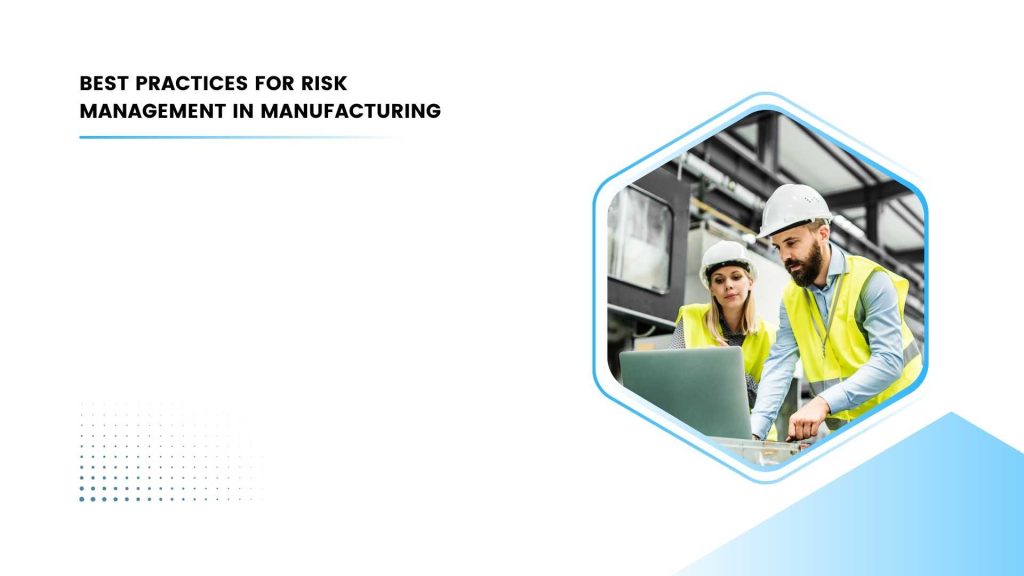Navigating and mitigating risks is crucial for sustained success in the active manufacturing landscape. From supply chain disruptions to regulatory changes, the manufacturing sector faces many challenges that can impact operations and profitability.
Implementing robust risk management practices is paramount to identifying potential threats and assessing and mitigating their impact. We will delve into the best practices for risk management in manufacturing, focusing on the three key steps: risk identification, risk assessment, and risk mitigation.
Risk Identification:
The first step in effective risk control is recognizing possible issues that could disrupt manufacturing functions. It involves a comprehensive assessment of threats to the organization, its operations, and its workforce.
Manufacturers must consider both external and internal factors that may pose risks. External risks may include supply chain disruptions, natural disasters, or geopolitical issues. Internal threats could involve equipment failures, workforce challenges, or regulatory compliance issues.
Manufacturers should conduct regular risk assessments, leverage historical data, and communicate openly with employees and stakeholders to enhance risk identification. This proactive approach enables the organization to anticipate and prepare for potential disruptions.
Risk Assessment:
Once possible risks are identified, the next step is to evaluate their likely impact and likelihood. It involves thoroughly analyzing each risk, considering the severity of the effects and the possibility of occurrence.
Manufacturers can allot resources effectively and focus on the most critical areas by quantifying and prioritizing risks. Risk assessment should be an ongoing process, adapting to changes in the business environment.
Utilizing risk assessment tools and technologies can aid in quantifying risks and ensuring a comprehensive evaluation. Manufacturers should consider the immediate impact and the long-term consequences of identified threats.
Risk Mitigation:
With a clear understanding of potential risks, the next crucial step is establishing mechanisms for monitoring and reviewing these risks. The goal is to reduce the likelihood of risks arising or minimize their impact if they do occur. It involves developing and implementing risk mitigation strategies and contingency plans.
Manufacturers can mitigate risks through diversifying suppliers, implementing redundant systems, investing in employee training, and staying compliant with industry regulations. Regularly reviewing and updating risk mitigation strategies is essential to ensure their relevance and effectiveness over time.
Some of the other Best Practices for Risk Management
- Regular risk assessments
- Robust supply chain management
- Employee training on safety protocols
- Continuous monitoring of equipment and machinery
- Implementation of quality control measures
- Adequate insurance coverage
- Emergency response planning
- Compliance with industry regulations
- Adoption of advanced technology for process optimization
- Collaboration with suppliers and stakeholders for risk mitigation.
Challenges for risk management in manufacturing
- Supply Chain Disruptions.
- Regulatory Compliance Complexity.
- Technological Changes and Cybersecurity Risks.
- Quality Control and Product Defects.
- Environmental and Sustainability Concerns.
- Geopolitical Instability.
- Talent Shortages and Workforce Challenges.
- Rapid Market Changes and Demand Volatility.
- Economic Downturns and Financial Risks.
- Natural Disasters and Unforeseen Events.
Benefits of Effective Risk Management in Manufacturing:
Enhanced Safety: Effective risk management can significantly reduce workplace calamities and ensure the safety of employees. Manufacturers create a secure working environment by identifying and addressing potential safety hazards.
Operational Efficiency: Mitigating risks leads to smoother operations, less downtime, and greater overall efficiency. By addressing potential disruptions in advance, manufacturers can maintain a consistent production flow, meet deadlines, and optimize resource utilization.
Conclusion:
ERP systems are pivotal in enhancing risk management within the manufacturing sector. ERP facilitates real-time data visibility, collaboration, and informed decision-making by providing a centralized platform that integrates various business processes.
This heightened transparency enables manufacturers to identify potential risks promptly, assess their impact, and implement effective mitigation strategies. Moreover, ERP systems contribute to operational efficiency, streamline processes, and ensure regulation compliance.
As manufacturing environments become increasingly complex, adopting ERP systems becomes a strategic advantage and a fundamental necessity for robust risk management, ultimately contributing to sustained growth and resilience in the face of dynamic challenges.

Vijay comes with a vast experience in ERP and enterprise solutions space with about 20 years of experience in various packaged application like Acumatica, SAP, Orion, Salesforce.com, SugarCRM and, SalesLogix.

